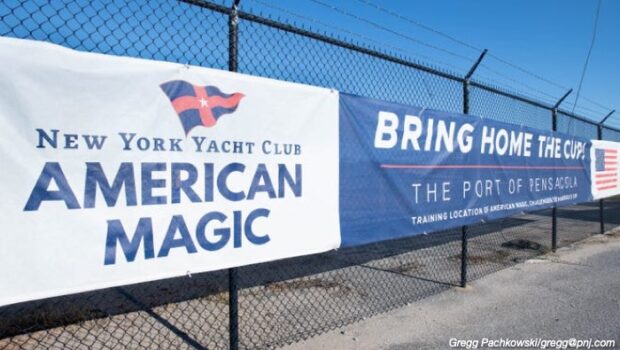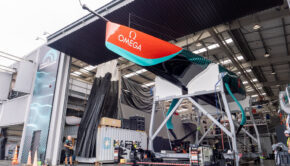Mission: Win the Cup
Published on March 1st, 2023
A visit to the American Magic base in Pensacola, Florida, reveals the scope of work underway and the urgency of the task ahead. Report by Gary Jobson for Sailing World:
America’s Cup training bases like that of the New York YC’s American Magic, are nothing fancy, but behind the curtained walls and inside modified shipping containers and mobile offices are vibrant centers of innovation, high-level sports training facilities, sophisticated workshops, technological research facilities and boatyards. Here, the work is mostly dirty and determined, yet the mission is clear: win the America’s Cup.
There are, of course, hundreds of moving parts that must be coordinated with a precision that any rank of military brass would appreciate, especially when the entire operation is wrapped, packed and shifted to Barcelona early this summer. Like every America’s Cup team dating back to the first defense in 1870, the goal in Pensacola is to create a fast boat and prepare a skilled crew.
The specifics of design technology, construction and tactical gambits are closely guarded secrets because often the smallest innovation can make the difference between victory and defeat. This much was reinforced during a recent visit with American Magic where the attitude of the team and the long to-do lists loomed large. Terry Hutchinson is the team’s skipper and head of the sailing team. He will not be sailing on the boat for this Cup, but is involved of every aspect of the program.
Veteran America’s Cup designer, Scott Ferguson, is overseeing the work of a 30-member design team, which includes, Len Imas, Pete Melvin and Britt Ward, all experienced America’s Cup hands. The design group was able to dive deep into the analytics of Patriot, American Magic’s AC75 which famously crashed and capsized in Auckland.
The second-generation AC75 hulls for Barcelona in 2024 will be about 1,000 kilograms lighter and the number of crew is reduced from eleven to eight. Winch grinders are replaced by cyclists who will pedal to make hydraulic power, which is used to trim the sails and operate several foil components. The boat itself is filled with a maze of wires, lines, and hydraulic tubes that spread like veins throughout the boat.
The hull must be strong to withstand heavy loads when sailing at high speeds (over 50 knots at times) and yet light enough for fast takeoff. It is a tricky balance to keep the boat on its foils throughout the entire race, especially given how difficult it is to take off in winds less than 8 knots.
Creating the correct foil package, therefore, is one of the most important tasks of the design team. The loads on the foils are tremendous.
Barcelona features choppy waves that will add more strain when foiling. Over the next several months, every team will experiment with up to four different foil designs on their AC40s or prototypes. Each team will be allowed to only race with one foil design. It can’t be changed once the competition starts. There are many design factors to consider: Should the foils be allowed to bend? Longer foils are easier to lift the boat out of the water, but slower once the boat is foiling. – Full report









 We’ll keep your information safe.
We’ll keep your information safe.